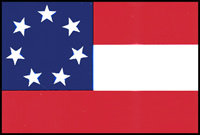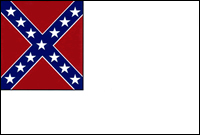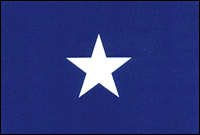Battle flag of the Army of Northern Virginia
 The Army of Northern Virginia battle flag was square, of various sizes for the different branches of the service: 52 inches (130 cm) square for the infantry, 38 inches (97 cm) for the artillery, and 32 inches (81 cm) for the cavalry. It was used in battle beginning in December 1861 until the fall of the Confederacy. The blue color on the saltire in the battle flag was navy blue, as opposed to the much lighter blue of the Naval Jack.
The Army of Northern Virginia battle flag was square, of various sizes for the different branches of the service: 52 inches (130 cm) square for the infantry, 38 inches (97 cm) for the artillery, and 32 inches (81 cm) for the cavalry. It was used in battle beginning in December 1861 until the fall of the Confederacy. The blue color on the saltire in the battle flag was navy blue, as opposed to the much lighter blue of the Naval Jack.
The flag's stars represented the number of states in the Confederacy. The distance between the stars decreased as the number of states increased, reaching thirteen when the secessionist factions of Kentucky and Missouri joined in late 1861
The Army of Northern Virginia battle flag assumed a prominent place post-war when it was adopted as the copyrighted emblem of the United Confederate Veterans. Its continued use by the Southern Army's post-war veterans groups, the United Confederate Veterans (U.C.V.) and the later Sons of Confederate Veterans, (S.C.V.), and elements of the design by related similar female descendents organizations of the United Daughters of the Confederacy, (U.D.C.), led to the assumption that it was, as it has been termed, "the soldier's flag" or "the Confederate battle flag".
First National Flag of the Confederacy: "The Stars and Bars" (1861-1863)
 The first official national flag of the Confederacy, often called the "Stars and Bars", was flown from March 4, 1861 to May 1, 1863. It was designed by German/Prussian artist Nicola Marschall in Marion, Alabama and resembles the Flag of the Austrian Empire (later Austria-Hungary, now the Republic of Austria), with which Marschall would have been familiar. The "Stars and Bars" flag was adopted March 4, 1861, in the first temporary national capital of Montgomery, Alabama, and raised over the dome of that first Confederate capitol.
The first official national flag of the Confederacy, often called the "Stars and Bars", was flown from March 4, 1861 to May 1, 1863. It was designed by German/Prussian artist Nicola Marschall in Marion, Alabama and resembles the Flag of the Austrian Empire (later Austria-Hungary, now the Republic of Austria), with which Marschall would have been familiar. The "Stars and Bars" flag was adopted March 4, 1861, in the first temporary national capital of Montgomery, Alabama, and raised over the dome of that first Confederate capitol.
The flag received criticism on ideological grounds for its aesthetic resemblance to the U.S. flag, which many Confederates disliked, seeing it as symbolizing of abolitionism and emancipation, which the Confederacy was officially in opposition to. As early as April 1861, a month after the flag's adoption, some were already criticizing the flag, calling it a "servile imitation" and a "detested parody" of the U.S. flag.
Originally designed with seven stars representing the original seven states of the Confederacy, stars were added as states joined the cause. Versions of the flag included nine, eleven and thirteen stars"
Second National Flag of the Confederacy: "The Stainless Banner" (1863-1865)
 During the solicitation for a second Confederate national flag, there were many different types of designs that were proposed, nearly all making use of the battle flag, which by 1863 had become well-known and popular among those living in the Confederacy. The new design was specified by the Confederate Congress to be a white field "with the union (now used as the battle flag) to be a square of two-thirds the width of the flag, having the ground red; thereupon a broad saltire of blue, bordered with white, and emblazoned with mullets or five-pointed stars, corresponding in number to that of the Confederate States.
During the solicitation for a second Confederate national flag, there were many different types of designs that were proposed, nearly all making use of the battle flag, which by 1863 had become well-known and popular among those living in the Confederacy. The new design was specified by the Confederate Congress to be a white field "with the union (now used as the battle flag) to be a square of two-thirds the width of the flag, having the ground red; thereupon a broad saltire of blue, bordered with white, and emblazoned with mullets or five-pointed stars, corresponding in number to that of the Confederate States.
The flag is also known as "the Stainless Banner" and was designed by William T. Thompson, a newspaper editor and writer based in Savannah, Georgia, with assistance from William Ross Postell, a Confederate blockade runner. The nickname "stainless" referred to the pure white field which took up a large part of the flag's design,
Third National Flag of the Confederacy: "The Blood-Stained Banner" (1865)
 The third national flag (also called "the Blood Stained Banner") was adopted March 4, 1865. The red vertical bar was proposed by Major Arthur L. Rogers, who argued that the pure white field of the Second National flag could be mistaken as a flag of truce: when hanging limp in no wind, the flag's Southern Cross canton could accidentally stay hidden, so the flag could mistakenly appear all white.
The third national flag (also called "the Blood Stained Banner") was adopted March 4, 1865. The red vertical bar was proposed by Major Arthur L. Rogers, who argued that the pure white field of the Second National flag could be mistaken as a flag of truce: when hanging limp in no wind, the flag's Southern Cross canton could accidentally stay hidden, so the flag could mistakenly appear all white.
Rogers lobbied successfully to have this alteration introduced in the Confederate Senate. He defended his redesign as having "as little as possible of the Yankee blue", and described it as symbolizing the primary origins of the people of the Confederacy, with the St. George's Cross of the English and British flags and the red bar from the flag of France.
Bonnie Blue (1861)
 The Bonnie Blue Flag was the flag of the short-lived Republic of West Florida of 1810 and closely resembles the flag that was used as the banner of the Confederate States of America at the start of the American Civil War in 1861. It consists of a single, five-pointed white star on a blue field.
The Bonnie Blue Flag was the flag of the short-lived Republic of West Florida of 1810 and closely resembles the flag that was used as the banner of the Confederate States of America at the start of the American Civil War in 1861. It consists of a single, five-pointed white star on a blue field.
The "Bonnie Blue Flag" was used as an unofficial flag during the early months of 1861. It was flying above the Confederate batteries that first opened fire on Fort Sumter, beginning the Civil War.


